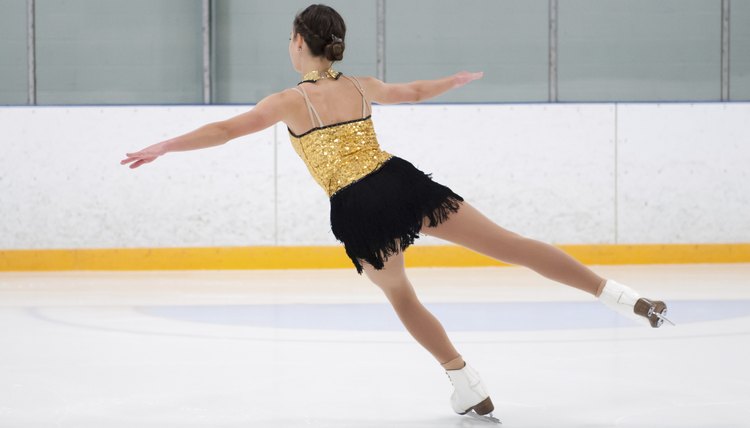Workouts for Figure Skaters

Figure skating is an artistic sport that utilizes a number of muscle groups, including your legs, hips, core region and shoulders. Strength training is necessary for figure skaters to promote strength for performing jumps, spins and increasing speed and power on the ice. Along with a consistent aerobic exercise program to build endurance, perform strength training for specific muscle groups at least twice a week.
Shoulder Workout
To strengthen your shoulders, use dumbbells to perform several key shoulder-strengthening exercises. Begin with military presses while either standing or sitting with your back straight, pushing the dumbbells straight above your head until your arms are straight. Move on to front raises while standing, lifting your arms from your sides until your arms are straight in front of you, parallel to the floor. Finish your shoulder workout with side lateral raises, keeping your arms slightly bent at the elbow and raising your arms out slightly to the side until they are again parallel to the floor.
Core Strength Training
Your core muscles, including various areas of your back and abdominal muscles, are important for strength in maintaining poses and balance while stabilizing your spine to prevent injury. Perform planks, sometimes referred to as bridges, to strengthen your core muscles. This exercise requires little movement as you lie on your abdomen with your upper body propped on your elbows and forearms. Lift your hips off the ground and hold this position for 10 seconds. Perform twisting crunches to strengthen your central abdominal muscles as well as your obliques. From the traditional crunch position, twist your torso left and right as your chest approaches your knees. Strengthen your upper back with dumbbell shrugs, and your central back with kneeling rows, kneeling on a weight bench with one arm supporting your body weight while performing rows with a dumbbell in the opposite hand. Finish your core training session by strengthening your lower back with deadlifts, performed with either a barbell or a dumbbell in each hand.
Lower-Body Strength Training
Strengthen your upper leg muscles and hips with squats and lunges. Perform weighted squats with a barbell resting across your lower shoulders or hold a dumbbell in each hand. Squat with a wider stance to strengthen your inner thigh muscles, and hold a narrower stance to work your outer thighs. Perform walking lunges back and forth across a room while holding a dumbbell in each hand or with a barbell across your shoulders. Strengthen your lower legs with calf raises, in which you rotate the position of your feet between sets. Point your toes forward to strengthen your central calves, point your toes inward to work your outer calf muscles and point your toes outward to strengthen your inner calves.
Implementation and Schedule
For strengthening your upper and lower body without producing large, bulky muscles, perform three sets of eight to 15 repetitions of each exercise during a workout, the U.S. Figure Skating organization recommends on its website. Strive to perform a total-body workout at least twice a week, allowing at least a full day of rest between workouts for muscle recuperation. Concentrate on proper technique during weightlifting. Seek help or training from a certified physical trainer if necessary to ensure that you are lifting weights properly and avoiding muscle or joint injury.
